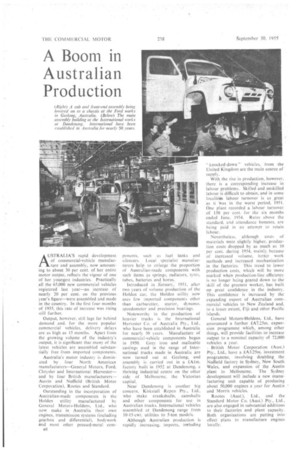A Boom in Australian Production
Page 42

If you've noticed an error in this article please click here to report it so we can fix it.
AUSTRAL1A'S rapid development of commercial-vehicle manufacture and assembly, now amounting to about 30 per cent. of her entire motor output, reflects the vigour of one of her youngest industries. Practically all the 65,000 new commercial vehicles registered last year—an increase of nearly 20 per cent. on the previous year's figure—were assembled and made in the country. In the first four months of 1955, this rate of increase was rising still further.
Output, however, still lags far behind demand and, for the more popular commercial vehicles. delivery delays are as high as 15 months. Apart from the growing volume of the industry's output, it is significant that many of the latest vehicles are assembled substantially free from imported components.
Australia's motor industry is dominated by four North American manufacturers—General Motors, Ford, Chrysler and International Harvester— and by four British manufacturersAuStill. and Nuffield (British Motor Corporation), Routes and Standard.
Outstanding in the incorporation of Australian-made components is the Holden utility manufactured by General Motors-Holdens, Ltd., who now make in Australia their own engines, transmission systems (includin a gearbox and differential), bodywork and most other pressed-metal corn
ponents, such as fuel tanks and silencers. Local specialist manufacturers help to enlarge the proportion of Australian-made components with such items as springs, radiators, tyres. tubes, batteries and horns.
Introduced in .finuary," 1951, after two years of volume production of the Holden car. the Holden utility now uses few imported components other than carburetter, starter, dynamo, speedometer and precision bearings.
Noteworthy in the production of heavier trucks is the International Harvester Co. of Australia Pty., Ltd., who have been established in Australia for nearly 50 years. Manufacture of commercial-vehicle components began
in .1950. Grey iron and malleable castings used in the range of International trucks made in Australia are now turned out at Geelong. and assembly is carried out in a IA factory built in 1952 at Dandenong. a thriving industrial centre on the other side or Melbourne, the Victorian capital.
Near Dandenong is another big concern. Kirkstall Repeo Pty., Ltd., who make crankshafts, camshafts and other components for use in Australian trucks. International vehicles assembled at Dandenong range from 10-15-cwt. utilities to 5-ton models.
Although Australian production is rapidly increasing, imports, inrluding knocked-down" vehicles, from the , United Kingdom are the main source of supply.
With the rise in production, however, there is a corresponding increase in labour problems. Skilled and unskilled labour is difficult to obtain, and in some localities labour turnover is as , great as it was in the worst period, 1951. One plant recorded a labour turnover of 150 per cent. for the six months ended June, 1954. Rates above the standard, and attendance bonuses, are being paid in an attempt to retain labour.
Nevertheless, although costs of materials were slightly higher, production costs dropped by as much as 10 per cent. during 1954, mainly, because of increased volume, better work methods and increased mechanization in the factories. This trend to lower production costs, which will he more marked when production' line efficiency is no longer being geared down to the skill of the greenest worker, has built up great confidence in the industry. This confidence is increased by the expanding export of Australian commercial vehicles to New Zealand and, to a lesser extent, Fiji and other Pacific islands.
General Motors-Holdens, Ltd., have announced a further 1A7.25m. expansion programme which, among other things, will provide facilities to increase output to a nominal capacity oT 72,000 vehicles a year.
. British Motor Corporation (Aust.) Pty., Ltd., have a £A3.25m. investment programme, involving doubling the Nuffield factory in Sydney, New South Wales, and expansion of the Austin plant in Melbourne. The Sydney development will include a new manufacturing unit capable of producing about 50,000 engines a year for Austin and Morris Vehicles.
Routes (Aust.), Ltd., and the Standard Motor Co. (Aust.) Pty., Ltd., are also engaged in substantial additions to their factories and plant capacity. Both organizations are putting into effect plans to manufacture engines locally.




























































































